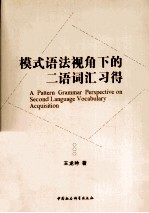

模式语法视角下的二语词汇习得 英文版PDF电子书下载
- 电子书积分:9 积分如何计算积分?
- 作 者:王龙吟著
- 出 版 社:北京:中国社会科学出版社
- 出版年份:2011
- ISBN:9787516103166
- 页数:173 页
Chapter 1 Introduction 1
1.1 Research orientation 1
1.2 Pattern:the object of research 1
1.3 Rationale 3
1.4 Key research questions 6
1.5 Organization of the book 7
Chapter 2 Pattern Grammar 9
2.1 Identification,definition,and presentation of"pattern" 9
2.2 A historical review of pattern grammar 11
2.2.1 Earlier work on patterns and usage 11
2.2.2 Research on word combinations 12
2.2.3 Lexical grammar 14
2.2.4 Pattern grammar 18
2.3 Two approaches to pattern grammar 21
2.3.1 Approach 1:A word and its patterns 21
2.3.2 Approach 2:A pattern and its words 22
2.4 Pattern-meaning association(PMA):core of pattern grammar 23
2.5 Summary 26
Chapter 3 Pattern Grammar and L2 Vocabulary Development 28
3.1 Pattern and depth of word knowledge 28
3.1.1 Depth of word knowledge 29
3.1.2 Associating pattern with depth of word knowledge 31
3.2 Depth of word knowledge and L2 vocabulary development 33
3.2.1 A unified account of dimensions of L2 vocabulary development research 33
3.2.2 Previous research on depth of L2 vocabulary development 38
3.3 Summary 41
Chapter 4 On the Corpus Method 42
4.1 Justifications for using learner corpora in SLA study 42
4.2 Advantages of using learner corpora in the present research 45
4.2.1 Learner corpora provide large quantities of natural language use data 45
4.2.2 Learner corpora provide a new text type for observation 47
4.3 Nature of corpus linguistics 50
4.3.1 Corpus linguistics is"a new way of thinking about language" 50
4.3.2 Corpora serve both as a test bed and as a source for hypotheses in SLA study 53
4.4 Limitations of using learner corpora in SLA study 54
4.5 Summary 55
Chapter 5 Methodology 57
5.1 Database 57
5.1.1 Preparing the learner corpus 58
5.1.2 Guaranteeing the comparability between different samples of the learner corpus 60
5.1.3 Preparing the control corpus 63
5.1.4 Guaranteeing the comparability between the control corpus and the learner corpus 64
5.2 Reseatch Tools 65
5.2.1 Wmatrix and CLAWS 66
5.2.2 Word Smith Tools 67
5.3 Analytical framework of the present research 68
5.4 Study 1:A word and its patterns—WAY 71
5.4.1 Selecting the research target 71
5.4.2 Research procedure 73
5.5 Study 2:A pattern and its words—V n1 to n2 77
5.5.1 Selecting the research target 78
5.5.2 Research procedure 81
5.6 Study 3:A simpler pattern and its words—V to n 87
5.6.1 Selecting the research target 87
5.6.2 Research procedure 89
5.7 Summary 90
Chapter 6 Results and Discussion 92
6.1 WAY and its patterns 93
6.1.1 PMA as sense-pattern correspondence 93
6.1.2 Effect of pattern complexity on PMA 96
6.1.3 Effect of length of learning experience on PMA 97
6.1.4 Summary of results relating to WAY 98
6.2 "V n1 to n2"and its words 99
6.2.1 PMA as meaning sharedness among words 99
6.2.2 Effect of length of learning experience on PMA 106
6.2.3 Summary of results relating to"V n1 to n2" 108
6.3 "V to n"and its words 108
6.3.1 Effect of pattern complexity on PMA concerning focal words 109
6.3.2 Effect of pattern complexity on PMA concerning non-focal words 110
6.3.3 Summary of results relating to"V to n" 113
6.4 Summary 113
Chapter 7 General Discussion 116
7.1 Interpreting L2 productive vocabulary development on Dimension 1—a word and its patterns 117
7.1.1 Reflections on PMA as sense-pattern correspondence 117
7.1.2 Reflections on effect of pattern complexity on PMA 119
7.1.3 Reflections on effect of length of learning experience on PMA 121
7.1.4 Summary of inferences on Dimension 1 121
7.2 Interpreting L2 productive vocabulary development on Dimension 2—a pattern and its words 122
7.2.1 Reflections on PMA as meaning sharedness among words 122
7.2.2 Reflections on effect of pattern complexity on PMA 127
7.2.3 Reflections on effect of length of learning experience on PMA 128
7.2.4 Summary of inferences on Dimension 2 129
7.3 Summary 129
Chapter 8 Conclusion 131
8.1 A recapitulation of the major findings 131
8.2 Implications 132
8.2.1 Implications for research into English patterns 132
8.2.2 Implications for research into depth of L2 vocabulary development 133
8.2.3 Implications for pedagogy 134
8.3 Limitations of the current research 136
8.4 Suggestions for future research 137
Appendices 138
References 164
- 《培生高级英语语法 练习册》培生教育 2019
- 《信息系统安全技术管理策略 信息安全经济学视角》赵柳榕著 2020
- 《大学英语教学的跨文化交际视角研究与创新发展》许丽云,刘枫,尚利明著 2020
- 《卓有成效的管理者 中英文双语版》(美)彼得·德鲁克许是祥译;那国毅审校 2019
- 《AutoCAD 2018自学视频教程 标准版 中文版》CAD/CAM/CAE技术联盟 2019
- 《跟孩子一起看图学英文》张紫颖著 2019
- 《改革进程中的刑事诉讼程序与证据问题研究 基于警察的视角》谢波 2019
- 《走出抑郁与焦虑 中西医视角下的心身同治》杨红琳 2019
- 《AutoCAD机械设计实例精解 2019中文版》北京兆迪科技有限公司编著 2019
- 《文化转向视角下的英汉翻译问题再审视》王燕著 2020
- 《红色旅游的社会效应研究》吴春焕著 2019
- 《中国当代乡土小说文库 本乡本土》(中国)刘玉堂 2019
- 《社会学与人类生活 社会问题解析 第11版》(美)James M. Henslin(詹姆斯·M. 汉斯林) 2019
- 《异质性条件下技术创新最优市场结构研究 以中国高技术产业为例》千慧雄 2019
- 《中国铁路人 第三届现实主义网络文学征文大赛一等奖》恒传录著 2019
- 《莼江曲谱 2 中国昆曲博物馆藏稀见昆剧手抄曲谱汇编之一》郭腊梅主编;孙伊婷副主编;孙文明,孙伊婷编委;中国昆曲博物馆编 2018
- 《中国制造业绿色供应链发展研究报告》中国电子信息产业发展研究院 2019
- 《中国陈设艺术史》赵囡囡著 2019
- 《指向核心素养 北京十一学校名师教学设计 英语 七年级 上 配人教版》周志英总主编 2019
- 《《走近科学》精选丛书 中国UFO悬案调查》郭之文 2019
